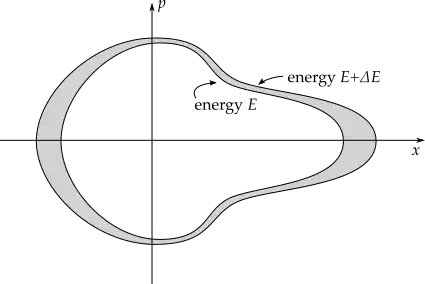A path integral approach might give a connection. Let's start with the quantum mechanical problem then show how one can take the classical limit. We have $N$, possibly interacting, particles. Let the position of the $i$-th particle be $\pmb{x}_i$, we can write the partition function as,
$$Z = \int \prod_i d\pmb{x}_i \int\prod_i D\pmb{x}^\prime_i(t) \ \exp\left[-\frac{1}{\hbar}\int_0^{\beta\hbar} \sum_i \left[\frac{m}{2} \dot{\pmb{x}}^{\prime
2}_i + V_{\text{ext}}(\pmb{x}^\prime_i) \right] + \sum_{i>j}V(|\pmb{x}^\prime_i - \pmb{x}^\prime_j|) \ d\tau \right].$$
Here $d\pmb{x}_i = dx_i dy_idz_i$, and $D\pmb{x}_i(t)$ is the path integral measure. In this integral, all paths start and end at the same position, that is $\pmb{x}_i(0) = \pmb{x}_i(\beta\hbar)$, for all paths.
In the classical limit $\beta\hbar$ is small. In this limit, the particle don't get enough time to move very far away form where they started in the path integral. The reason for this is the kinetic energy term in the Lagrangian, this term make paths with very high velocities not contribute much to the integral, and for small $\beta\hbar$, paths with not very high velocities don't move very far from their staring point. With this approximation, we can treat the potientials as being constant, and take them out of the integral.
$$Z = \int \prod_i d\pmb{x}_i \ \exp\left[-\beta \left(\sum_i V_{\text{ext}}(\pmb{x}_i) + \sum_{i>j}V(|\pmb{x}_i - \pmb{x}_j|) \right) \right] \int\prod_i D\pmb{x}^\prime_i(t) \ \exp\left[-\frac{1}{\hbar}\int_0^{\beta\hbar} \sum_i \frac{m}{2} \dot{\pmb{x}}^{\prime
2}_i \ d\tau \right].$$
What is left of the path integral is just a a bunch of free particles. I will spare you the details and use,
$$\int D\pmb{x}(t) \ \exp\left[-\frac{1}{\hbar}\int_0^{\beta\hbar} \sum_i \frac{m}{2} \dot{\pmb{x}}^2 \ d\tau \right] = \left(\frac{m}{2\pi \hbar^2 \beta}\right)^{3/2},$$
for paths that start and end at the same position. The partition function then become,
$$Z = \left(\frac{m}{2\pi\hbar^2\beta}\right)^{3N/2} \int \prod_i d\pmb{x}_i \ \exp\left[-\beta \left(\sum_i V_{\text{ext}}(\pmb{x}_i) + \sum_{i>j}V(|\pmb{x}_i - \pmb{x}_j|) \right) \right].$$
Now I can use the following,
$$\left(\frac{m}{2\pi\hbar^2\beta}\right)^{3N/2} = \frac{1}{h^{3N}}\int\prod_i d\pmb{p}_i \exp\left[-\beta\frac{\pmb{p}_i^2}{2m} \right] $$
to write the partition function as,
$$Z = \frac{1}{h^{3N}} \int \prod_i d\pmb{p}_i d\pmb{x}_i \ \exp\left[-\beta \left(\frac{\pmb{p}_i^2}{2m} + \sum_i V_{\text{ext}}(\pmb{x}_i) + \sum_{i>j}V(|\pmb{x}_i - \pmb{x}_j|) \right) \right]. $$
This is nothing but the classical expression for the partition function. In classical mechanics, the partition function is defined up to a constant, however taking this classical limit we know what that constant is. Whenever there is a sum over all states in classical mechanics, we have $\frac{1}{h^{3N}} \int \prod_i d\pmb{p}_i d\pmb{x}_i$. You can read more about this from Feynman and Hibbs' book Path integrals in Quantum Mechanics, they have a section on statistical mechanics.
